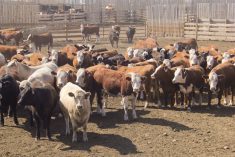Chicago | Reuters — U.S. soybean futures jumped to a two-week high on Wednesday after the U.S. Department of Agriculture (USDA) unexpectedly cut its U.S. harvest forecast and raised imports by top soy buyer China in a monthly report.
Soybean price gains were held in check, however, by expectations for large South American crops that will compete with U.S. shipments in the global marketplace.
Corn futures ended near unchanged on the day as USDA’s cuts to demand by exporters and ethanol producers largely offset support from a smaller harvest outlook.
Read Also

U.S. livestock: Feeder cattle hit contract highs on tight supply
Chicago | Reuters – All Chicago Mercantile Exchange feeder cattle futures and most live cattle futures hit contract highs on…
Wheat declined as the government lowered its supply forecast by less than the consensus trade estimate.
Chicago Board of Trade November soybeans settled up 19-3/4 cents at $13.96 a bushel, the highest since Sept. 30 (all figures US$). The actively traded contract hit overhead technical resistance around the $14 level and its 20- and 50-day moving averages.
December corn was steady at $6.93 per bushel while CBOT December wheat dropped 18-3/4 cents to $8.82-1/4 a bushel.
In its monthly supply-and-demand report, USDA said the country’s corn and soy crops would be smaller than previously forecast, raising concerns about tight global inventories. Analysts, on average, had expected a corn production cut but a rise in the soy crop.
“The big surprise is the soybean production cut,” said Karl Setzer, commodity risk analyst for AgriVisor.
“But if you look at South American production, which USDA bumped up a bit, and you look at the global carryout, which was also increased a bit, all of that tempers the news a bit,” he said.
Grain traders continue to monitor grain shipments from the Black Sea region after an escalation in Russian missile strikes on Ukraine that lifted wheat and corn to three-month highs on Monday.
— Reporting for Reuters by Karl Plume in Chicago; additional reporting by P.J. Huffstutter in Chicago, Gus Trompiz in Paris and Naveen Thukral in Singapore.
















